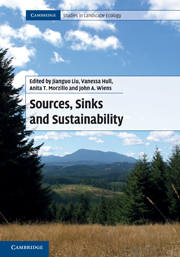Book contents
- Frontmatter
- Contents
- Contributors
- Preface
- Acknowledgments
- Part I Introduction
- Part II Advances in source–sink theory
- Part III Progress in source–sink methodology
- Part IV Improvement of source–sink management
- 16 Contribution of source–sink theory to protected area science
- 17 Evidence of source–sink dynamics in marine and estuarine species
- 18 Population networks with sources and sinks along productivity gradients in the Fiordland Marine Area, New Zealand: a case study on the sea urchin Evechinus chloroticus
- 19 Source–sinks, metapopulations, and forest reserves: conserving northern flying squirrels in the temperate rainforests of Southeast Alaska
- 20 Does forest fragmentation and loss generate sources, sinks, and ecological traps in migratory songbirds?
- 21 Source–sink population dynamics and sustainable leaf harvesting of the understory palm Chamaedorea radicalis
- 22 Assessing positive and negative ecological effects of corridors
- Part V Synthesis
- Index
- References
18 - Population networks with sources and sinks along productivity gradients in the Fiordland Marine Area, New Zealand: a case study on the sea urchin Evechinus chloroticus
Published online by Cambridge University Press: 05 July 2011
- Frontmatter
- Contents
- Contributors
- Preface
- Acknowledgments
- Part I Introduction
- Part II Advances in source–sink theory
- Part III Progress in source–sink methodology
- Part IV Improvement of source–sink management
- 16 Contribution of source–sink theory to protected area science
- 17 Evidence of source–sink dynamics in marine and estuarine species
- 18 Population networks with sources and sinks along productivity gradients in the Fiordland Marine Area, New Zealand: a case study on the sea urchin Evechinus chloroticus
- 19 Source–sinks, metapopulations, and forest reserves: conserving northern flying squirrels in the temperate rainforests of Southeast Alaska
- 20 Does forest fragmentation and loss generate sources, sinks, and ecological traps in migratory songbirds?
- 21 Source–sink population dynamics and sustainable leaf harvesting of the understory palm Chamaedorea radicalis
- 22 Assessing positive and negative ecological effects of corridors
- Part V Synthesis
- Index
- References
Summary
Many coastal marine populations are made up of networks of discrete subpopulations of relatively sedentary adults linked by larval dispersal at the mesoscale (10–100 km). Patterns in abundance, and structure of populations at this scale are strongly influenced by the interaction of hydrodynamic forcing on larval dispersal with patterns in adult productivity and larval production. This issue is particularly important in the 14 fjords that indent the southwest coast of New Zealand, which present a highly fragmented and diverse array of marine habitats with strong gradients in benthic productivity, and with larval transport in each fjord dominated by estuarine circulation. Population structure of sea urchins (Evechinus chloroticus) was illustrated across this region by examining trends in size frequency distributions from 53 sites sampled in 2002. A consistent pattern was observed, with sea urchin populations from the kelp-dominated fjord entrances consistently displaying a large adult mode (mean test diameter 110–130 mm) with evidence for gradual recruitment of individuals into the population, while populations from the inner fjords showed two distinct patterns. At many inner-fjord sites a large frequency of recently emergent recruits 50–60 mm indicated strong recruitment events and high demographic variability, while at some sites populations had undergone complete mortality of the adult mode and at sampling were made up of only a single juvenile cohort. These patterns likely reflect a source–sink population structure across the benthic productivity gradients within each fjord. This has important implications for the efficacy of a network of eight new marine reserves (10,241 ha) and 14 commercial exclusion zones (46,002 ha) established within the inner fjords under the Fiordland Marine Management Act 2005, and for the sustainability of this fragmented marine system.
- Type
- Chapter
- Information
- Sources, Sinks and Sustainability , pp. 382 - 398Publisher: Cambridge University PressPrint publication year: 2011
References
- 7
- Cited by

